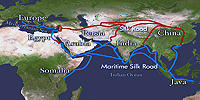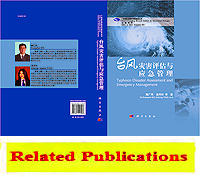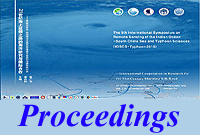|
|
The 5th International Symposium on Remote Sensing of
the
Indian Ocean-South China Sea and Typhoon Sciences
(IOSCS-Typhoon
2015)
--International
Cooperation in Research for the 21st Century Maritime Silk Road
21世纪海上丝绸之路的海洋研究与国际合作—
第5届印度洋-南海海洋遥感与台风科学国际大会
http://lingzis.51.net/Typhoon2015/Typhoon2015.htm
Conference Venue:
Guangdong University of Foreign Studies
Date: 24-26 Aug, 2015.
Chairman: DanlingTang,86
13924282728
POSTER
|
Session 8:
Poster
Chair:
Stefano Vignudelli,
Consiglio Nazionale delle Ricerche (CNR), Italy
Co-Chair:
Khin Kyu Kyu,
Myanmar Maritime University, Myanmar
Ping Shi,State
Key Laboratory of Tropical Oceanography,
CAS, China
|
|
No. |
Presenter |
Affiliation |
Title |
|
P-1 |
Changgao Shao |
South
China Sea Institute of Oceanology, CAS,
China |
Spatial
variability of deep-water sediment porewater
pH and related water-column characteristics
in the northern South China Sea |
|
P-2 |
Chaoran
Cui,
Yuping Guan |
South China Sea Institute
of Oceanology, CAS,
China |
Variation
trend of wind power input to surface waves
in the South China Sea |
|
P-3 |
Chunli Liu |
Marine College, ShanDong
University |
Seasonal and geographic variations in
modeled primary production and phytoplankton
losses from the mixed layer between warm and
cold years on the eastern Bering Sea shelf |
|
P-4 |
Duoyou Chen |
The Faculty of Aslan Languages and Cultures,
Guangdong University of Foreign Studies |
万国公法的翻译对日本近代化的影响 |
|
P-5 |
Haijun Ye |
South China Sea
Institute of Oceanology, CAS,
China |
Effects of typhoon and rainfall on pCO2
in
anti-cyclonic eddy in the Northern South
China Sea |
|
P-6 |
Hualing Ma
Zhangjin Wei |
Guangdong
University of Foreign Studies |
Trend Assessment of Typhoon
Disasters Based on the Improved
Entropy Method |
|
P-7 |
Gang Pan |
South China Sea Institute
of Oceanology, CAS,
China |
Satellite remote sensing data and its
application in
the 21st Century Maritime Silk Road |
|
P-8 |
Guoqi Ding |
The Faculty of Aslan
Languages and Cultures, Guangdong
University of Foreign Studies |
近代日本从“攘夷”到“开化”之思维转换中的中国因素 |
|
P-9 |
Guoqiang Qiu |
Xiamen University |
Physical and biogeochemical
responses to typhoon
“Rammasun”
observed from a Bio-Argo float and
satellites in the South China Sea |
|
P-10 |
Guangjun Sui , He Chen |
Guangdong University of Foreign Studies |
Comprehensive Impact and Defensive Measures
for Typhoon Disasters -A Case Study of
Typhoon |
|
P-11 |
Jing Sun |
South China Sea Institute of Oceanology, CAS,
China |
Detections of Small and Medium Size Oil
Spills in the South China Sea
using Quad-polarization Data of Radarsat2
Satellite |
|
P-12 |
Jun Sun |
Tianjin University of
Science and Technology |
Phytoplankton Species Composition in Eastern
Indian Ocean |
|
P-13 |
Khin Kyu Kyu |
Myanmar Maritime University |
Forecasting on Myanmar Marine Ecosystem
Changes into Fisheries Resources |
|
P-14 |
Linai Cai |
South China Sea
Institute of Oceanology, CAS,
China |
Remote sensing of spatial-temporal
distribution of suspended sediment and
analysis of related environmental
factors in Hangzhou Bay, China |
|
P-15 |
Aimin Yang, Jianghao Lin
et. al., |
Guangdong University of
Foreign Studies |
System of Typhoon Disaster Loss Assessment
(1) |
|
P-16 |
Jianghao Lin, Aimin Yang et.al., |
Guangdong University
of Foreign Studies |
System of Typhoon Disaster Loss
Assessment (2) |
|
P-17 |
Jiujuan Wang |
Division of Ocean
Science and Technology, Graduate
School at Shenzhen, Tsinghua
University |
Statistical analysis of submesoscale
processes and phytoplankton biomass
near Luzon Strait from satellite
observations |
|
P-18 |
Shuguo Lv |
Hainan Research Academy of Environmental
Sciences |
Identification of Susceptibility of harmful
algal blooms and determining the key
monitoring zones in the coastal water of
Hainan Island |
|
P-19 |
Wenzhao Liang |
South China Sea
Institute of Oceanology, CAS,
China |
Influence of Physical Processes on
Phytoplankton Size Classes in the
Western South China Sea in Summer,2014 |
|
P-20 |
Yanying Lin |
The Faculty of
Aslan Languages and Cultures,
Guangdong University of Foreign
Studies |
广州十三行与海上丝绸之路 |
|
P-21 |
Yupeng Liu,Yuwei Yin |
South China Sea Institute of Oceanology, CAS,
China |
Remote
sensing in flood detecting |
|
P-22 |
Yu Zhang,
Yuping Guan |
South China Sea Institute
of Oceanology, CAS,
China |
Intercomparison of one-dimensional detecting
methods of unveiling the global ocean
striations |
|
P-23 |
Zhiquan Sun,
Yuping Guan |
South China Sea
Institute of Oceanology;
PLA University of Science and Technology |
Recent Decades Strengthening of Pacific
Walker Circulation |
|
P-24 |
Yongjun Song |
South China Sea
Institute of Oceanology, CAS,
China |
New Ecological Index for Sea Surface
Temperature Cooling Response to
Tropical Cyclones in South China Sea |
|
P-25 |
Zhigang Zhang |
The Faculty of Aslan
Languages and Cultures, Guangdong University
of Foreign Studies |
中日学者眼中的“郑和下西洋”—以中国知网和日本CiNii上登载的论文为分析对象— |
|
|
P-26 |
Research Center for Remote Sensing of Marine
Ecology & Environment (RSMEE) |
South China Sea Institute
of Oceanology, CAS,
China |
南海及邻近海域藻华形成演变过程
机制与遥感监测方法—研究意义和
总体思路 |
|
P-27 |
Research Center for Remote Sensing of Marine
Ecology & Environment (RSMEE) |
South China Sea Institute
of Oceanology, CAS,
China |
南海及邻近海域藻华形成演变过程
机制与遥感监测方法—主要完成人
|
|
P-28 |
Research Center for Remote Sensing of Marine
Ecology & Environment (RSMEE) |
South China Sea Institute
of Oceanology, CAS,
China |
南海及邻近海域藻华形成演变过程
机制与遥感监测方法—首次提出“南海西部:强风-上升流-藻华”形成演变的动力理论与概念模型 |
|
P-29 |
Research Center for Remote Sensing of Marine
Ecology & Environment (RSMEE) |
South China Sea Institute
of Oceanology, CAS,
China |
南海及邻近海域藻华形成演变过程机制与遥感监测方法—“南海西部:强风上升流-藻华”形成演变的动力理论与概念模型第三方评论 |
|
P-30 |
Research Center for Remote Sensing of Marine
Ecology & Environment (RSMEE) |
South China Sea Institute
of Oceanology, CAS,
China |
南海及邻近海域藻华形成演变过程
机制与遥感监测方法—台风海洋过程的生态学效应研究,揭示藻华过程的三维结构与生消规律 |
|
P-31 |
Research Center for Remote Sensing of Marine
Ecology & Environment (RSMEE) |
South China Sea Institute
of Oceanology, CAS,
China |
南海及邻近海域藻华形成演变过程
机制与遥感监测方法—海啸等极端海洋过程的生态学效应研究 |
|
P-32 |
Research Center for Remote Sensing of Marine
Ecology & Environment (RSMEE) |
South China Sea Institute
of Oceanology, CAS,
China |
南海及邻近海域藻华形成演变过程
机制与遥感监测方法—利用遥感、GIS等新技术分析阐明南海有害藻华的时空分布特征与机理 |
|
P-33 |
Research Center for Remote Sensing of Marine
Ecology & Environment (RSMEE) |
South China Sea Institute
of Oceanology, CAS,
China |
南海及邻近海域藻华形成演变过程
机制与遥感监测方法—藻华的遥感监测与空间数据挖掘 |
|
P-34 |
Research Center for Remote Sensing of Marine
Ecology & Environment (RSMEE) |
South China Sea Institute
of Oceanology, CAS,
China |
南海及邻近海域藻华形成演变过程
机制与遥感监测方法—国际学术影响 |
|
P-35 |
Research Center for Remote Sensing of Marine
Ecology & Environment (RSMEE) |
South China Sea Institute
of Oceanology, CAS,
China |
南海及邻近海域藻华形成演变过程
机制与遥感监测方法—推进海洋遥感应用和社会服务 |
|
|

感谢HRS帮助制作本会议网页
| |
















